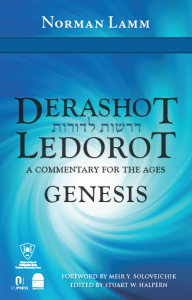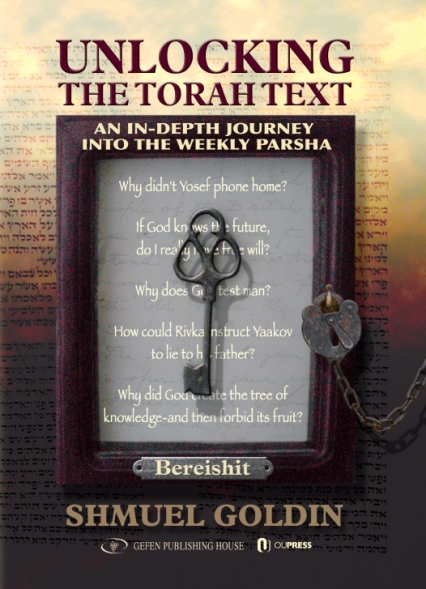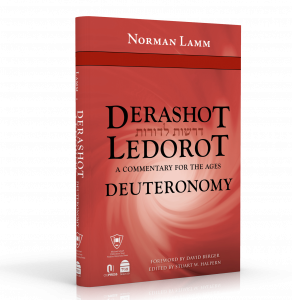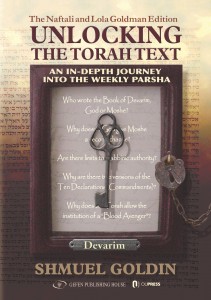Excerpted from Rabbi Dr. Norman J. Lamm’s Derashot Ledorot: A Commentary for the Ages – Genesis, co-published by OU Press, Maggid Books, and YU Press; edited by Stuart W. Halpern
 Down the Up Staircase*
Down the Up Staircase*
For over a thousand years, the weekly Torah portions have been known by their present names with only minor changes. According to the Lubavitcher Rebbe, these titles are “Torah names,” headings to which the Torah gives special significance, for they somehow reveal the inner essence of the whole of the sidra.
This Torah portion is called Lekh Lekha, which means, “Get thee out,” be active and move. Literally, the idiom means, “Go to yourself,” return to your spiritual identity, climb up the ladder to spiritual heights, reach your own soul in your ascent. A Jew must never be static. He must be dynamic and progressive in his service of the Lord, in moving himself and history in the direction of God. This, then, is the essence of all that is related in this sidra. Thus, we read of how Abram goes to the land of Israel. He is not traveling as a sightseeing tourist with first-class accommodations. His journey is a symbolic conquest. As Nachmanides points out, Abram’s journeys in Canaan prefigured the Jewish possession of the land by actual possession when he staked out the territory. All of this is part of Abram’s “going,” his lekh lekha.
However, there are several important incidents which spell not progress but decline. The foremost failure or setback is the verse: “And there was famine in the land and Abram went down to Egypt” (Genesis 12:10). This is not merely an incidental decision to change residence. Psychologically, it was a major crisis for Abram. He had left Canaan with the divine promise, “I shall make you into a great nation and I shall bless you.” Some blessing! He had just come to Canaan, and instead of bringing with him prosperity, he had become the harbinger of hunger, and he was already fleeing the land.
What a disappointment – history’s first oleh had become history’s first yored.
Religiously, too, Abram’s descent to Egypt was frustrating, almost abortive of his whole mission. His journey to Canaan was meant to be a kiddush Hashem, an act of sanctifying the divine Name by making the one God available and accessible to humans. The Midrash compares the situation to an open box of incense. If it stands in a corner, no one can smell it and it is of no use. But if you take it and move it about in the middle of the room, then your motion causes the odor to be wafted and to benefit all who are present. So God said to Abram: “Move yourself from place to place in Canaan, and thus will your name be made great in the world” – and through your reputation will the divine Name be sanctified and the divine message be known. The journey to Canaan was to be the launching of Abram’s religious career. However, if Abram “went down” to Egypt, that canceled out his mission and vitiated his message.
Domestically, this descent to Egypt was the cause of many troubles for Abram. For in Egypt there took place the abduction of Sara – she was kidnapped and taken into the harem of Pharaoh. So our sidra relates troubles as well as triumphs.
And, spiritually and historically as well, we are faced with problems in this sidra. We know the principle that our rabbis laid down, “Ma’aseh avot siman levanim” – the deeds of the fathers are the symbol of the recurring patterns in the lives of their children. But some Jewish teachers, especially Hasidim, taught that this does not mean only that the lives of the patriarchs were symbolic of the historic patterns of their descendants, but that the patriarchs actually participated in the history that came after them, that their actions were the commencement of Jewish history. Therefore, “And Abram went down to Egypt” means not only that Abram’s descent to Egypt was a historic symbol of the later Egyptian exile, but that it was in some way itself the beginning of that terrible and bitter exile.
If that is the case, and such were the blows suffered by Abram and Sara, how can we account for the name Lekh Lekha, which indicates progress, growth, and advancement?
The answer provided for us by the Lubavitcher Rebbe is, in essence, this: Sometimes descent is for the purpose of ascent; often you must go down in order to go up to an even higher level than that at which you began. Some failures are merely temporary; they are the future successes in disguise. Sometimes the setback is instrumental to later success. Often you must retreat in order to move on, in which case the retreat is preparatory and part of progress and advance.
Therefore, “Vayered Avram Mitzrayma,” Abram’s going down to Egypt, led to and was part of “Vaya’al Avram miMitzrayim,” Abram’s going up again from Egypt. His going down was part and for the purpose of his later going up.
Even Sara’s abduction to the harem of Pharaoh served such a function. One of the great Hasidic teachers has taught us that Sara’s chaste conduct in the court of Pharaoh was so exemplary that it became the model for Jewish conduct through the centuries of exile in foreign lands. The descendants of Sara, inspired by her model, refused to assimilate. They did not permit the purity of their faith be defiled, they protected the honor of their emuna in God.
So “vayered” is part of “vaya’al,” the descent leading to the ascent is all part of lekh lekha, of general progress. Or, to use a metaphor more familiar to us from the popular literature of recent years, sometimes you go down, but it is only going “down the up staircase”; your decline is merely a part of the procedure of ultimate ascent. So it is with our national life. Joseph was sold by his brothers into slavery. At the time Joseph, and later all the brothers, thought that this event was an unmitigated disaster. But, as Joseph later told them when he revealed his identity to them, “The agony of my slavery was part of the divine plan to save the entire family now.” He went down – but it was on the up staircase, which led even higher.
The same is true with the State of Israel today. Often we are plunged into a gray mood when we consider our international and even internal situation. The constant attrition, the state of no-war-no-peace, the ever-impending threat of greater warfare involving the great powers, the increasing isolation of Israel from neutrals and friends – all this is not calculated to encourage great cheer on behalf of those who love Israel. Nevertheless, we must never permit ourselves to lose our sense of balance. We are only humans, and therefore our perspectives are limited. Even we, in our present situation, can begin to appreciate that quite possibly our present situation is the best of all, that the alternatives may be far worse, that what is happening at the present may be propaedeutic to something much greater, much nobler, much happier. Our present descent may well be part of an ultimate ascent. May God grant that!
And the same holds true for personal life. Life is full of crises. No human being can be spared trauma in his existence. If we lose heart and are discouraged and become crushed, then our pessimism is a self-fulfilling prophecy. We lose sight of opportunities, and we almost wish ourselves into a plunging descent. But if we look at our situation as descent for the sake of ascent, if we adopt a more sanguine attitude, then our optimism becomes self-fulfilling as it sensitizes us to the creative possibilities in descent. So let us leave the pessimistic views to the anti-Semites. Recall what Zeresh, wife of Haman, told him when his star began to dim: “If Mordecai, before whom you have begun to fall, is one of the children of the Jews, then you shall not prevail over him but you will fall completely” (Esther 6:13). There was a descent which was permanent. Jews must take a different attitude. For ourselves we must learn to endure the descent as integral to the ascent, as but a temporary setback, preparation for a greater rise.
How often has a middle-aged man, suffering a heart attack, been told by his physician: How lucky you are! This is a warning which may well save your life and prolong it. The same is true for business or professional or academic setbacks. It may be a warning, it may save us from more disastrous adventures, it may teach us something whereby we will better be able to attain our ultimate goal.
This message is not simplistic, unrealistic, or happy-go-lucky. On the contrary, I am pleading for a more sophisticated and higher realism: the confidence and rational understanding that, caught in crisis, man is often prone to depression because he takes an overly dim view, because he is limited emotionally and his vision is therefore curbed; the knowledge that life is never all up or all down, but a series of zigzags – and he never knows when he is zigging or zagging; the faith that while our own personal perspective is limited, that we can only begin to discern events and their true proportions in retrospect but never in prospect, that from the perspective of God what seems to us like descent is really for the purpose of ascent. Because we are so affected personally by our own situation, we tend to exaggerate, and we do not know that we are doing so or in what measure. In the depths, it is hard to realize that you have gone down in order to go up. But it is an act of faith – and intelligence as well.
So, Lekh Lekha, both by content and by name, leaves us with this encouraging message: If we suffer, whether it be illness, financial reverses, or any form of domestic misery or loneliness or frustration, remember “descent for the purpose of ascent.” I do not mean that things will always get better, but they often do, little as we expect it. Let us then not despair. Let each of us, in his or her own situation, bear this in mind – not as a palliative or peace-of-mind preachment, but as part of emuna, part of Jewish faith.
Then it will be true of us, as it was said of Abram in this sidra: “And he (Abram) believed in the Lord, and He accounted to him as tzedaka, as righteousness” (Genesis 15:6). By this is meant that God considered Abram’s faith as a special act of righteousness. But the word “tzedaka” derives from the word meaning “justice.” We might therefore translate the verse as: “And Abram believed in the Lord, and God accredited it to him and justified his faith.”
When we will have faith that the downturn is part of an up-going, that the descent is for the ascent, and that faith will prove tzedaka, our confidence will be vindicated and justified, and indeed aloh na’aleh. The call of Lekh Lekha, of climbing ever higher, will be ours to achieve.
*October 30, 1971.








